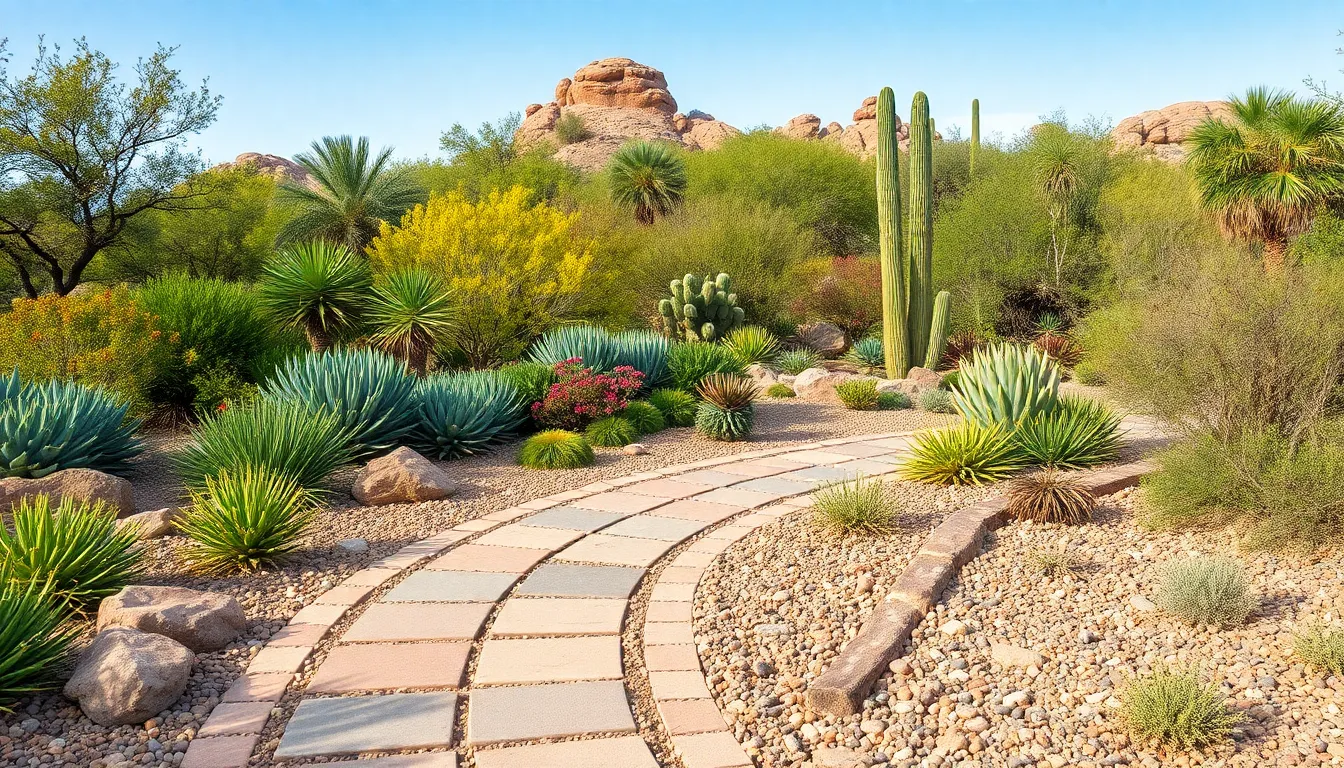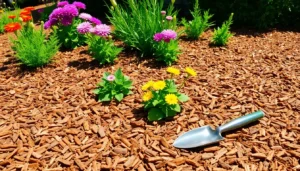Desert landscaping isn’t just about surviving the heat; it’s about thriving in it. Imagine transforming your yard into a stunning oasis that’s as low-maintenance as a cactus and as vibrant as a sunset. With the right plants and design, you can create a landscape that not only conserves water but also turns heads faster than a tumbleweed in a windstorm.
Forget the traditional grass lawns that scream for attention and water. Embrace the beauty of drought-resistant plants, colorful rocks, and creative hardscapes. Whether you’re a seasoned gardener or just someone who wants to impress the neighbors, desert landscaping offers endless possibilities. Get ready to ditch the watering can and say hello to a landscape that’s both eco-friendly and effortlessly stylish.
Table of Contents
ToggleOverview of Desert Landscaping
Desert landscaping focuses on creating sustainable outdoor spaces that thrive in arid climates. Choosing drought-resistant plants significantly reduces water usage while maintaining beauty. Various succulents like agaves and cacti serve as attractive focal points. Colorful rocks and gravel enhance the aesthetic while providing effective ground cover.
Innovative hardscaping techniques reduce maintenance requirements. Paving stones, patios, and pathways create functional outdoor areas with minimal water needs. Incorporating native plants promotes biodiversity and attracts beneficial wildlife.
Water conservation techniques play a crucial role in desert landscaping. Drip irrigation systems efficiently deliver moisture directly to plant roots. Rainwater harvesting systems make use of collected storm runoff for irrigation purposes.
Integrated design elements enhance both function and beauty. Mixing textures and colors creates visual interest and depth. The selection of materials should align with the overall theme of the landscape.
Careful planning ensures that the resulting space is both practical and visually appealing. Arranging plants in clusters rather than rows promotes a more natural feel. Complementing architectural features with appropriate landscaping creates cohesive designs.
Overall, desert landscaping not only beautifies spaces but also promotes environmental stewardship. By minimizing water use and maximizing aesthetic value, homeowners can create lasting outdoor environments. Leveraging these principles leads to effective, attractive landscaping solutions suited for arid environments.
Benefits of Desert Landscaping

Desert landscaping offers several advantages that appeal to homeowners. Water conservation and low maintenance are two significant benefits that stand out.
Water Conservation
Water conservation plays a vital role in desert landscaping. Drought-resistant plants thrive with minimal irrigation, significantly decreasing water usage. For instance, succulents and native vegetation require only a fraction of the water compared to traditional lawns. Implementing drip irrigation systems ensures efficient moisture delivery, minimizing waste. Rainwater harvesting systems capture natural precipitation, further enhancing water efficiency. Homeowners can significantly reduce their monthly water bills while creating eco-friendly landscapes. Sustainable practices, like mulching and selecting xeriscape plants, promote healthy soils and plants, ensuring a thriving environment even in arid conditions.
Low Maintenance
Low maintenance creates a favorable environment for busy homeowners. Desert landscapes require less attention than traditional gardens, making them ideal for those with limited time. Drought-resistant plants generally withstand harsh conditions without frequent care. Using gravel and rocks as ground cover eliminates the need for mowing and excessive upkeep. Additionally, innovative hardscaping techniques often limit weed growth, helping maintain a tidy appearance. With minimal water demand and reduced labor, families can spend more time enjoying their outdoor spaces instead of working in them. Overall, desert landscaping simplifies outdoor living while enhancing beauty and functionality.
Design Principles of Desert Landscaping
Design principles of desert landscaping center on creating an appealing and functional space that thrives in arid climates. By implementing smart choices in plant selection and hardscaping, homeowners achieve beautiful yet practical landscapes.
Choosing the Right Plants
Selecting the right plants significantly impacts a desert landscape’s sustainability. Drought-resistant varieties, such as agave, yucca, and various succulents, require minimal water and adapt well to dry conditions. Incorporating native shrubs, like desert willow or sage, enhances biodiversity and supports local wildlife. Grouping plants with similar water needs aids in efficient irrigation. Planting annuals among perennials adds color and vibrancy while maintaining low water usage. This combination creates an attractive focal point while minimizing maintenance.
Hardscaping Elements
Incorporating hardscaping elements enhances both functionality and aesthetics in desert landscaping. Using materials like decomposed granite, flagstone, and pavers creates pathways and patios that withstand heat. Integrating boulders contributes texture and serves as natural focal points throughout the space. Arranging hardscapes to facilitate drainage prevents pooling during infrequent rains. Utilizing raised beds optimizes planting space and promotes better soil drainage. Overall, thoughtful hardscaping balances natural beauty with practical use, making outdoor spaces inviting and efficient.
Popular Plants for Desert Landscaping
Selecting the right plants is crucial for creating a thriving desert landscape. Focus on varieties that withstand arid conditions while adding visual interest.
Succulents and Cacti
Succulents and cacti thrive in dry climates, making them popular choices for desert landscapes. Varieties like Aloe vera store water in their leaves, reducing irrigation needs. Agave plants, known for their architectural form, offer striking focal points. Additionally, prickly pear cacti produce vibrant flowers and edible fruits. These plants require minimal maintenance, allowing homeowners to enjoy their beauty without extensive care. Their diverse shapes, colors, and textures enhance the overall aesthetic, providing year-round interest.
Drought-Resistant Shrubs
Drought-resistant shrubs play an essential role in desert landscaping. Native species like desert sage and creosote bush adapt well to arid environments, requiring little water. These shrubs often attract local wildlife, adding ecological value to the landscape. Other options include Red Yucca, which produces tall flower stalks that attract hummingbirds. Selecting shrubs with varying heights creates visual layers, enriching the overall design. Grouping shrubs according to their water needs maximizes irrigation efficiency, fostering a sustainable garden.
Common Mistakes in Desert Landscaping
Homeowners often make mistakes that undermine their desert landscaping efforts. Choosing non-native plants leads to increased maintenance and water usage. Many individuals underestimate the need for proper soil preparation, which can result in poor plant health. Ignoring local climate conditions contributes to plant failure, especially during extreme weather.
Another frequent error involves over-watering, which negatively impacts plant health. Applying too much irrigation can drown plants, contrary to the goals of desert landscaping. Over-mulching also creates issues by suffocating roots and hindering water penetration.
People sometimes select plants based solely on appearance, neglecting their water requirements. Grouping plants with differing needs complicates irrigation and increases water waste. Failing to create a functional layout is another common pitfall, as it limits accessibility and usability within the landscape.
Many landscapers overlook the significance of hardscaping elements, which complement plant life. Focusing solely on greenery neglects the aesthetic potential of rocks and gravel that enhance visual appeal. Designing without considering drainage can lead to water accumulation, causing erosion and damage.
Ignoring seasonal changes also affects maintenance and plant choices. They must account for seasonal variations to ensure a thriving landscape year-round. Failing to monitor plant growth and health results in overgrown areas that detract from the landscape’s intended look.
Homeowners frequently miss out on using native plants that naturally thrive in arid environments. Native species require less maintenance and provide ecological benefits, such as supporting local wildlife. Prioritizing sustainable practices creates a harmonious and resilient outdoor space that flourishes in desert conditions.
Desert landscaping presents a unique opportunity for homeowners to create stunning outdoor spaces that thrive in arid climates. By embracing drought-resistant plants and innovative hardscaping techniques, they can achieve beautiful, low-maintenance gardens that conserve water and enhance curb appeal.
This sustainable approach not only reduces water usage but also fosters biodiversity and supports local wildlife. With careful planning and the right plant selections, homeowners can enjoy vibrant landscapes that require minimal upkeep while making a positive environmental impact. Adopting desert landscaping principles is a step toward a more sustainable future, transforming outdoor areas into inviting retreats that reflect both beauty and practicality.







